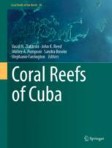Search
Search Results
-
Effects of light intensity and spectral composition on the growth and physiological adaptation of Acroporid corals
Light affects physiological aspects of coral growth. However, it is unclear how light conditions (photoperiod, intensity, and spectrum) influence...

-
Broad-scale spatial distribution and microhabitat-scale substrate association of seven angelfish species (family Pomacanthidae) in an Okinawan coral reef
Species-specific spatial distribution in relation to environmental characteristics underpins the species diversity of coral reef fishes. This study...

-
Using coral holes to explore the historical ecology of Guam’s coral reefs
Push-coring is used to collect Holocene-aged coral sub-fossils, but its applications can be limited by underlying reef geology. Here, we report on a...

-
Rapid recovery of coral communities from a mass bleaching event in the summer of 2016, observed in Amitori Bay, Iriomote Island, Japan
Devastating bleaching of coral communities at Amitori Bay, Iriomote Island, Japan, occurred in 2016 during the third global mass bleaching event in...

-
Assessing coral reef conservation planning in Wakatobi National Park (Indonesia) from larval connectivity networks
Wakatobi National Park (WNP), located in the heart of the Coral Triangle in Indonesia, is one of the most biodiverse marine habitats on Earth. Coral...

-
Macroalgal presence decreases coral calcification rates more than ocean acidification
Global coral reef degradation has precipitated phase shifts toward macroalgal-dominated communities. Despite the negative repercussions for...

-
Population and clonal structure of Acropora cf. hyacinthus to inform coral restoration practices on the Great Barrier Reef
A key goal of coral restoration is to re-establish self-sustaining coral populations and ensure resilience to future stressors, which requires that...

-
Variance of coral anti-pathogen defense in response to transplantation between coral- and macroalgal-dominated reefs
Coral reefs are undergoing precipitous decline due to coral bleaching and disease following warming events, with impacted reefs often shifting from...

-
Insights from Cuban Coral Reefs
In the 1970s, the Cuban coral reefs were the object of extensive exploration. The results were published in Spanish, Russian, French, and German but...
-
Morphotype is not linked to mitochondrial haplogroups of Caribbean acroporid hybrids
The Caribbean Acropora corals, A. palmata and A. cervicornis form a hybrid with two broad morphotypes, bushy and palmate. These morphotypes were...

-
Stony coral tissue loss disease decimated Caribbean coral populations and reshaped reef functionality
Diseases are major drivers of the deterioration of coral reefs and are linked to major declines in coral abundance, reef functionality, and...

-
Management of scleractinian coral assemblages in temperate non-reefal areas: insights from a long-term monitoring study in Kushimoto, Japan (33°N)
In this era of global climate change, understanding fundamental mechanisms of coral community maintenance and persistence in temperate non-reefal...

-
Degradation of Coral Reefs under Complex Impact of Natural and Anthropogenic Factors with Nha Trang Bay (Vietnam) as an Example
Until recently, the city of Nha Trang, which stretches along Nha Trang Bay of southern Vietnam, was known as the “Riviera of the South China Sea”...

-
Coral reef collapse in South-Central Vietnam: a consequence of multiple negative effects
Repeated coral reef surveys conducted in 2016–2021 in the coastal area of Nui Chua National Park in Ninh Thuan Province (South-Central Vietnam),...

-
Larval precompetency and settlement behaviour in 25 Indo-Pacific coral species
Knowledge of coral larval precompetency periods and maximum competency windows is fundamental to understanding coral population dynamics, informing...

-
Studying functions on coral reefs: past perspectives, current conundrums, and future potential
Function-based studies have opened a new chapter in our understanding of coral reefs. Unfortunately, we are opening this chapter as the world’s reefs...

-
Calcification rates of a massive and a branching coral species were unrelated to diversity of endosymbiotic dinoflagellates
BackgroundTo explore the possibility that endosymbiotic dinoflagellates (Symbiodiniaceae) are associated with coral calcification rates, we...

-
Comparative genomics highlight the importance of lineage-specific gene families in evolutionary divergence of the coral genus, Montipora
BackgroundScleractinian corals of the genus Montipora (Anthozoa, Cnidaria) possess some unusual biological traits, such as vertical transmission of...

-
Maximizing Genetic Diversity in Coral Restoration Projects
As natural coral populations decline, thousands of outplanted corals are poised to dominate reefs in the hardest-hit areas, such as the Florida Keys....
-
The coral symbiont Candidatus Aquarickettsia is variably abundant in threatened Caribbean acroporids and transmitted horizontally
The symbiont “ Candidatus Aquarickettsia rohweri” infects a diversity of aquatic hosts. In the threatened Caribbean coral, Acropora cervicornis , Aquarickettsia...

